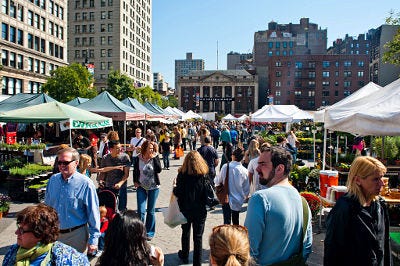going to the farmers market
Earlier this week, I went to the Union Square Greenmarket, one of New York City’s largest and most consistent farmers markets. It was my first time, which is unfortunate because it was brimming with seasonal produce, freshly baked bread, beautiful flowers, local honey, sustainable seafood, jams, sauces, maple syrup, and even wine and liquor.
I’d been missing out. Despite living in New York for more than 2 years, a grad student schedule (and budget) and an established routine had kept me from shopping at farmers markets.
But as someone who chooses to center ecology and conservation in my life, I really should take the time to prioritize farmers markets.
For one thing, farmers markets are generally more sustainable than the grocery store. Grocery stores are supplied by large-scale farms that typically focus on one or two massive crops. These crops are not necessarily suited to their habitat and therefore require the use of chemical fertilizers, pesticides, herbicides, and destructive tilling practices to maximize their harvest.
In contrast, small, local farms have a vested interest in the ecology of their land. They grow a variety of regional crops that usually require fewer pesticides and fertilizers and less mechanization1. Farmers tend their land with a focus on longevity rather than yield.
Crop diversity is invaluable for the environment. Agriculture often decreases biodiversity, so planting a variety of crops can provide a dynamic habitat for native microbes, fungi, and animals (including pollinators!).
Small farms also frequently have a lower carbon footprint, although that is difficult to quantify. Farmers market produce travels much shorter distances compared to cargo ships that bring us blueberries from Chile, but per pound of produce it might average out.
Regardless, produce from small farms still has to take fewer trucks, trains, and ships to bring us our food. And keeping our produce regional is great for the local economy. Your money goes to people and places within your community instead of corporate conglomerates like Monsanto.
It’s obvious that farmers market produce is good for the planet, but it can also be the healthier option for consumers.
Fruits and vegetables from the farmers market are always seasonal, meaning they were grown in optimal conditions. They contain higher levels of vitamins and minerals than those grown out of season, and they usually taste better too! I personally think there’s nothing better than a farmers market nectarine in the summer.
And because small, local farms are likely to be organic, utilizing fewer pesticides and fertilizers, there is a much lower chance that shoppers will end up ingesting harmful chemicals.
But as I mentioned, I tended to dismiss farmers markets because of the cost. Many people have a perception of farmers markets as being unreasonably pricey, and they opt for the grocery store instead.
However, when I was shopping at the greenmarket, I found most of the prices to be similar to those in the grocery store. And upon further research, farmers market prices across the country are competitive, or even cheaper, than those at grocery stores. Because produce is seasonal, the cost of production and labor is offset by the lack of transportation and fertilization.
Additionally, many farmers markets accept SNAP benefits, which makes them much more attainable for low-income shoppers.
There is often less access to fresh fruits and vegetables in low-income neighborhoods, a circumstance known as a “food desert.” While it can still be difficult for people in these communities to get to a farmers market, the fact that markets accept SNAP benefits is definitely a step in right direction. Any way to introduce more fresh produce into peoples’ lives is a good thing.
There is also a sense of community at the farmers market, one I think everyone should get the chance to experience. You might run into friends and neighbors, or strike up a conversation with a local farmer. It’s more than just a place to buy this week’s groceries.
I may not get the opportunity to go to the Union Square Greenmarket again, as my time in New York is coming to an end, but I’ll make sure to seek out my local farmers market in my new home. It’s good for the planet, it’s good for our health, and it’s just a fun time.
And as we head into fall, here is a list of seasonal fruits and vegetables to look for at your local farmers market:
- apples, grapes, bananas, figs, pears, persimmons, cranberries, lemons, kiwi
- broccoli, cauliflower, kale, squash & pumpkin, bell peppers, beets, sweet potatoes & yams, spinach, onions, garlic, carrots, collard greens
1. Warsaw, P., Archambault, S. He, A., Miller, S. (2021). The Economic, Social, and Environmental Impacts of Farmers Markets: Recent Evidence from the US. Sustainability. 13:3423. doi.org/10.3390/su13063423



